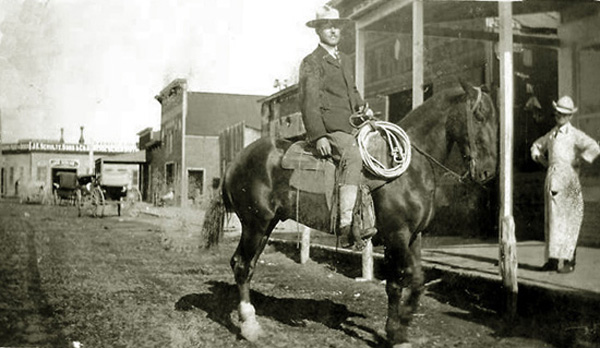
West Second Street, looking west, undated.
The two story barn several buildings down from the man on the horse is the Grand Central Stable. Beyond on the curve is
the Schulte Hardware Company sheep wagon works. The building burned in September, 1954.
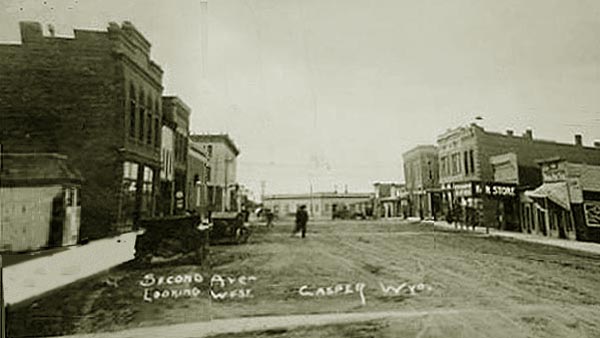
Second Street, looking west from intersection with Wolcott, Photo by Gleason, approx. 1912.
At the end of the street is the Shulte Hardware Company building. One block toward the viewer from Shulte's is Center Street. On the left side
of the street on the southwest corner of Center and Second is the Grand Central Hotel.
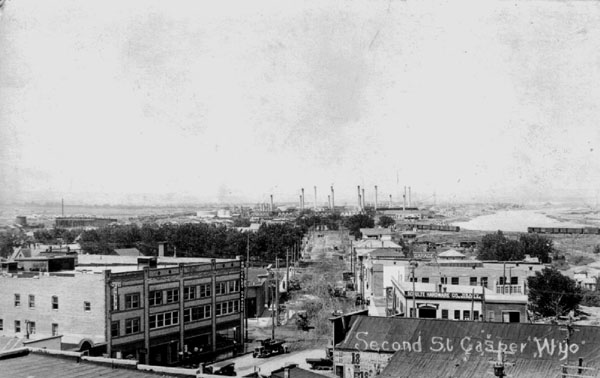
Second Street, looking west toward the Midwest Refinery, approx. 1920.
The three story building on the left is the Shockley Service & Sales Company garage. The Shockley Garage was formed by Clarence
Shockley and Joe E. Mansfield about 1917. In 1918, the two did a full tour of the state to promote good roads and
the "good roads" movement and Pierce-Arrow motor cars and trucks and F.W.D Trucks for whom they were agents. They also served as agents for
Stutz, Chandler and Oakland cars.
Clarence Shockley was a well-known over-the-road automobile race driver. At Frontier Park he did a one mile lap in only 61 seconds.
In 1917 in a big Stutz, he raced the Denver Post Frontier Days special from Denver to Cheyenne. He beat the train achieving the 112 miles in two hours and nine minutes.
In 1920, he drove from Casper to Denver in only eight hours and 45 minutes. The same year he participated in a race from Denver to Pueblo for the opening of the Colorado State Fair.
Driving a Studebaker, he placed fourth. Primary investors in the Shockley Garage were, however,
Lslie I. Gantz, J. C. Snook, and Mansfield. The original investors sold off their ownerhip interests between 1917 and 1919. Mansfield establsihed the
Packard Motor Car Agency and for a short period of time Shockley had an interest in a Stanley and Nash agency.
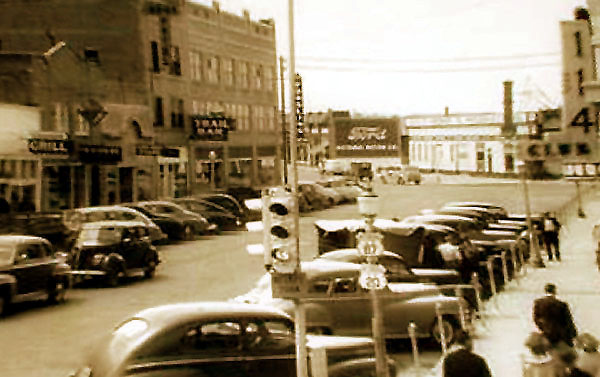
Second Street, looking west from Center Street, approx. 1947.
On the right side of the photo is the sign for the 114 Club. During World War II, the 114 was popular with service men training at the
Casper Army Air Corps base. Alvin Brown who wrote for the Slip Stream, the base newspaper,
recalled that at the base "the fellows were either working at the base or are down at the 114 Club." For those who had a pass to go into town, the
club was convenient. The bus made a stop at the corner of 2nd Street and Center. One pilot of a B-24 Liberator bomber who had trained at Casper went so far as to
name his tent at Pantanella, Italy, the "114 Club." The signs for the rest rooms in the club were illuminated by bulbs behind the letters.
One time, a bulb behind the letters "WO" for the women's room burned out, causing a little confusion. The Bar closed in 1952.
On the left side of the street next to the Garage is the Trail Bar. Above was a Knights of Columbus Hall.
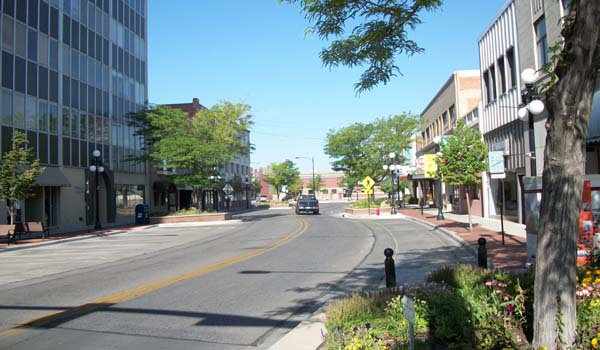
Second Street, looking west from Center Street, 2013. Photo by Geoff Dobson.
The changes to Second Street to the east of Center over the years has been less drastic consisting primarily of the disappearance of
large chain stores. The dominating structure is the Midwest Building on the corner of Second and Wolcott.
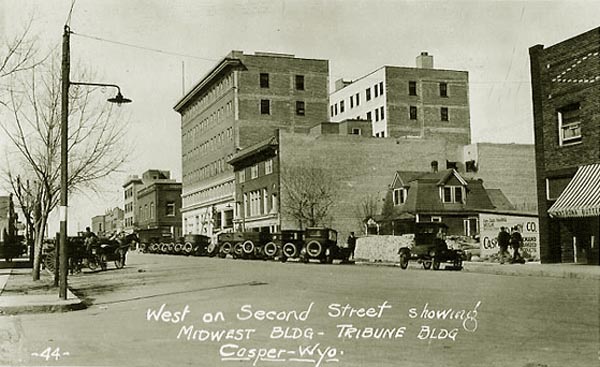
Second Street, looking west approx. 1921
The Midwest Building opened in 1921. On the ground floor opening onto Second Street was the Wyoming National Bank.
The main entrance into the bank was a vestibule constructed of Vermont marble. The doors were made of bronz along with a revolving door.
Within the main banking floor were two octagonal pillars also made of Vermont marble. The ceiling was 18 feet high. Dark walnut
wainscoating decorated the walls. There were ten tellars cages. Behind the tellers cages was a massive
telephone switch board serving the buildings twenty instruments. The vault was in the basement served by a hydraulic lift. On the banking floor
were three desks for the president of the bank, former governor B. B. Brooks and the vice-president and the cashier.
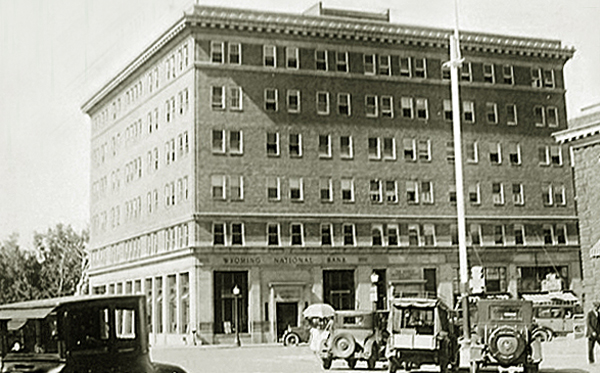
Midwest Building corner of Second and Wolcott, 1920's.
About 1929, in order to guide pilots the Casper Rotary Club placed on the roof a sign, "CASPER' in chrome yellow 12-foot letters with a giant arrow pointing to
Casper's landing field 4 1/2 miles away.

Midwest Building corner of Second and Wolcott, 1924.
The bank moved to an ultra modernistic concrete building in 1964.
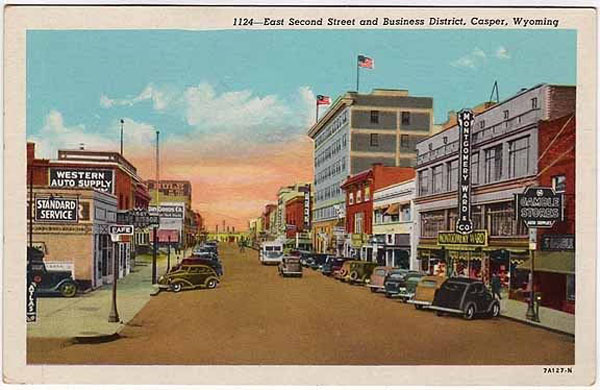
Second Street, looking west, 1930's.
Tt the very end of the street can be made out Schulte's and beyond it the stacks of the Standard Refinery. At one time Gamble's [to the left of "Monkey Wards" as Montgomery Wards was commonly called] was the 15th larged chain of retail stores in the
United States with some 4,300 stores in 39 states and Canada. In 1980, Gambles was sold to the
Wickes Corporation on a leveraged buyout. In 1982 the chain filed for bankruptcy.
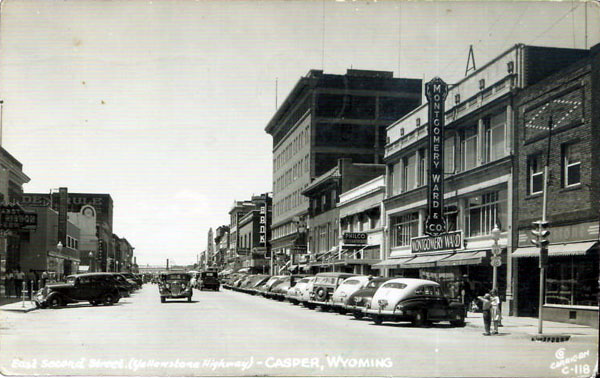
Second Street, looking west, 1940's. Photo by Thomas Carrigen.
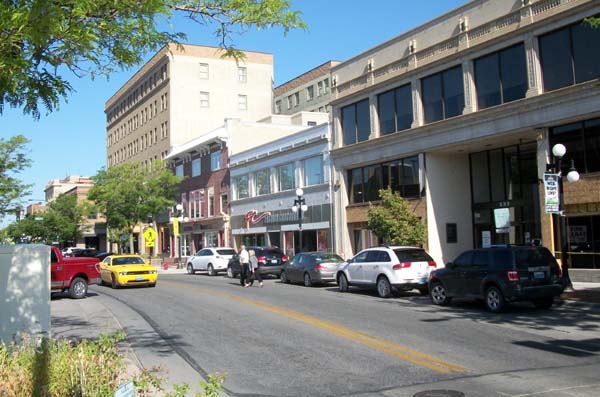
Second Avenue, Looking West, 1913. Photo by Geoff Dobson
Next page: An old-fashioned Fourth of July